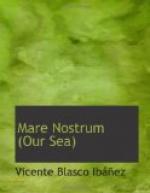The largest of the lobsters (the homard, the sovereign of the tables of the rich) was resting upon the scissors of its front claws, as powerful as an arm, or a double battle-axe. The spiny lobster was leaping with agility over the peaks, by means of the hooks on its claws, its weapons of war and nutrition. Its nearest relative, the cricket of the sea, a dull and heavy animal, was sulking in the corners covered with mire and with sea weed, in an immovability that made it easily confounded with the stones. Around these giants, like a democracy accustomed to endure from time to time the attack of the strong, crayfish and shrimps were swimming in shoals. Their movements were free and graceful, and their sensitiveness so acute that the slightest agitation made them start, taking tremendous springs.
Ulysses kept thinking of the slavery that Nature had imposed upon these animals, giving them their beautiful, defensive envelopment.
They were born armored and their development obliged them repeatedly to change their form of arms. They sloughed their skins like reptiles, but on account of their cylindrical shape were able to perform this operation with the facility of a leg that abandons its stocking. When it begins to crack, the crustaceans have to withdraw from out their cuirass the multiple mechanism of their members and appendages,—claws, antennae and the great pincers,—a slow and dangerous operation in which many perish, lacerated by their own efforts. Then, naked and disarmed, they have to wait until a new skin forms that in time is also converted into a coat of mail,—all this in the midst of a hostile environment, surrounded with greedy beasts, large and small, attracted by their rich flesh,—and with no other defense than that of keeping themselves in hiding.
Among the swarm of small crustaceans moving around on the sandy bottom, hunting, eating, or fighting with a ferocious entanglement of claws, the onlookers always search for a bizarre and extravagant little creature, the paguro, nicknamed “Bernard, the Hermit.” It is a snail that advances upright as a tower, upon crab claws, yet having as a crown the long hair of a sea-anemone.
This comical apparition is composed of three distinct animals one upon the other—or, rather, of two living beings carrying a bier between them. The paguro crab is born with the lower part of his case unprotected,—a most excellent tid-bit, tender and savory for hungry fishes. The necessity for defending himself makes him seek a snail shell in order to protect the weak part of his organism. If he encounters an empty dwelling of this class, he appropriates it. If not, he eats the inhabitant, introducing his posterior armed with two hooked claws into its mother-of-pearl refuge.
But these defensive precautions are not sufficient for the weak paguro. In order to live he needs rather to put himself on the offensive, to inspire respect in devouring monsters, especially in the octopi that are seeking as prey his trunk and hairy claws, exposed to locomotion outside his tower.




